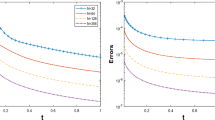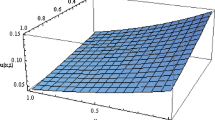Abstract
In this paper, we are concerned with the numerical solutions of the coupled fractional Klein-Gordon-Schrödinger equation. The numerical schemes are constructed by combining the Crank-Nicolson/leap-frog difference methods for the temporal discretization and the Galerkin finite element methods for the spatial discretization. We give a detailed analysis of the conservation properties in the senses of discrete mass and energy. Then the numerical solutions are shown to be unconditionally bounded in L2 −norm, \(H^{\frac {\alpha }{2}}-\)semi-norm and \(L^{\infty }-\)norm, respectively. Based on the well-known Brouwer fixed-point theorem and the mathematical induction, the unique solvability of the discrete solutions is proved. Moreover, the schemes are proved to be unconditionally convergent with the optimal order \(O\left (\tau ^{2}+h^{r+1}\right )\), where τ is the temporal step, h is the spatial grid size, and r is the order of the selected finite element space. Furthermore, by using the proposed decoupling and iterative algorithms, several numerical examples are included to support theoretical results and show the effectiveness of the schemes. Finally, the fast Krylov subspace solver with suitable circulant preconditioner is designed to effectively solve the Toeplitz-like linear systems. In each iterative step, this method can effectively reduce the memory requirement of above each finite element scheme from \({{O}\left (M^{2}\right )}\) to O(M), and the computational complexity from \({O\left (M^{3}\right )}\) to \({O(M \log M)}\), where M is the number of grid nodes. Numerical tests are carried out to show that this fast algorithm is more practical than the traditional backslash and LU factorization/Cholesky decomposition methods, in terms of memory requirement and computational cost.











Similar content being viewed by others
Notes
In fact, it finds that the preconditioned PGPBiCOR and PCG method indeed converges to the default stopping criterion 1e-12 in 5 iteration steps.
References
Banquet, C., Ferreira, L.C., Villamizar-Roa, E.J.: On existence and scattering theory for the Klein–Gordon–Schrodinger̈ system in an infinite L2-norm setting. Ann. Mat. Pura Appl. 194(3), 781–804 (2015)
Shi, Q.-H., Li, W.-T., Wang, S.: Wellposedness in energy space for the nonlinear Klein–Gordon–Schrodinger̈ system. Appl. Math. Comput. 251, 55–64 (2015)
Guo, B.: Global solution for some problem of a class of equations in interaction of complex Schrodinger̈ field and real Klein-Gordon field. Sci. China Ser. A 25, 97–107 (1982)
Zhang, L.: Convergence of a conservative difference scheme for a class of Klein–Gordon–Schrodinger̈ equations in one space dimension. Appl. Math. Comput. 163(1), 343–355 (2005)
Bao, W., Yang, L.: Efficient and accurate numerical methods for the Klein–Gordon–Schrodinger̈ equations. J. Comput. Phys. 225(2), 1863–1893 (2007)
Wang, T.: Optimal point-wise error estimate of a compact difference scheme for the Klein–Gordon–Schrodinger̈ equation. J. Math. Anal. Appl. 412(1), 155–167 (2014)
Wang, S., Zhang, L.: A class of conservative orthogonal spline collocation schemes for solving coupled Klein–Gordon–Schrodinger̈ equations. Appl. Math. Comput. 203 (2), 799–812 (2008)
Hong, J., Jiang, S., Kong, L., Li, C.: Numerical comparison of five difference schemes for coupled Klein–Gordon–Schrodinger̈ equations in quantum physics. J. Phys. A Math. Theor. 40(30), 9125 (2007)
Li, M., Shi, D., Wang, J., Ming, W.: Unconditional superconvergence analysis of the conservative linearized Galerkin FEMs for nonlinear Klein-Gordon-Schrodinger̈ equation. Appl. Numer. Math. 142, 47–63 (2019)
Laskin, N.: Fractional quantum mechanics. Phys. Rev. E 62(3), 3135 (2000)
Ran, M., Zhang, C.: A conservative difference scheme for solving the strongly coupled nonlinear fractional Schrödinger equations. Commun. Nonlinear Sci. Numer. Simulat. 41, 64–83 (2016)
Tarasov, V.E., Zaslavsky, G.M.: Fractional Ginzburg–Landau equation for fractal media. Phys. A 354, 249–261 (2005)
Guo, B., Huo, Z.: Well-posedness for the nonlinear fractional Schrodinger̈ equation and inviscid limit behavior of solution for the fractional Ginzburg-Landau equation. Fract. Calc. Appl. Anal. 16(1), 226–242 (2013)
Li, M., Huang, C.: An efficient difference scheme for the coupled nonlinear fractional Ginzburg–Landau equations with the fractional Laplacian. Numer. Meth. Part. Differ. Equ. 35(1), 394–421 (2019)
Cheng, X., Duan, J., Li, D.: A novel compact ADI scheme for two-dimensional Riesz space fractional nonlinear reaction–diffusion equations. Appl. Math. Comput. 346, 452–464 (2019)
Li, D., Wu, C., Zhang, Z.: Linearized Galerkin FEMs for nonlinear time fractional parabolic problems with non-smooth solutions in time direction. J. Sci. Comput. 80(1), 403–419 (2019)
Cao, J., Song, G., Wang, J., Shi, Q., Sun, S.: Blow-up and global solutions for a class of time fractional nonlinear reaction–diffusion equation with weakly spatial source. Appl. Math. Lett. 91, 201–206 (2019)
Huang, C., Guo, B., Huang, D., Li, Q.: Global well-posedness of the fractional Klein-Gordon-Schrodinger̈ system with rough initial data. Sci. China Math. 59(7), 1345–1366 (2016)
Alqahtani, R.T.: Approximate solution of non-linear fractional Klein-Gordon equation using spectral collocation method. Appl. Math. Comput. 6(13), 2175 (2015)
Khader, M.M.: An efficient approximate method for solving linear fractional Klein–Gordon equation based on the generalized Laguerre polynomials. Int. J. Comput. Math. 90(9), 1853–1864 (2013)
Wang, Z., Vong, S.: A compact difference scheme for a two dimensional nonlinear fractional Klein–Gordon equation in polar coordinates. Comput. Math. Appl. 71(12), 2524–2540 (2016)
Wang, J., Aiguo, X.: An efficient conservative difference scheme for fractional Klein-Gordon-Schrodinger̈ equations. Appl. Math. Comput. 320, 691–709 (2018)
Li, D., Liao, H.-L., Sun, W., Wang, J., Zhang, J.: Analysis of L1-Galerkin FEMs for time-fractional nonlinear parabolic problems. Commun. Comput. Phys. 24, 86–103 (2018)
Li, C., Zhao, Z., Chen, Y.: Numerical approximation of nonlinear fractional differential equations with subdiffusion and superdiffusion. Comput. Math. Appl. 62 (3), 855–875 (2011)
Li, M., Huang, C., Wang, P.: Galerkin finite element method for nonlinear fractional Schrödinger equations. Numer. Algor. 74(2), 499–525 (2017)
Li, M., Huang, C., Wang, N.: Galerkin finite element method for nonlinear fractional Ginzburg-Landau equation. Appl. Numer. Math. 118, 131–?149 (2017)
Secchi, S.: Ground state solutions for nonlinear fractional Schrodinger̈ equations in RN. J. Math. Phys. 54(3), 031501 (2013)
Li, S., Vu-Quoc, L.: Finite difference calculus invariant structure of a class of algorithms for the nonlinear Klein–Gordon equation. SIAM J. Numer. Anal. 32(6), 1839–1875 (1995)
Wang, P., Huang, C.: A conservative linearized difference scheme for the nonlinear fractional Schrodinger̈ equation. Numer. Algor. 69, 625–641 (2015)
Li, M., Zhao, Y.-L.: A fast energy conserving finite element method for the nonlinear fractional Schrödinger equation with wave operator. Appl. Math. Comput. 338, 758–773 (2018)
Ran, M., Zhang, C.: A conservative difference scheme for solving the strongly coupled nonlinear fractional Schrodinger̈ equations. Commun. Nonlinear Sci. Numer. Simulat. 41, 64–83 (2016)
Li, M., Gu, X.-M., Huang, C., Fei, M., Zhang, G.: A fast linearized conservative finite element method for the strongly coupled nonlinear fractional Schrödinger equations. J. Comput. Phys. 358(1), 256–282 (2018)
Gu, X.-M., Huang, T.-Z., Ji, C.-C., Carpentieri, B., Alikhanov, A.A.: Fast iterative method with a second-order implicit difference scheme for time-space fractional convection–diffusion equation. J. Sci. Comput. 2017, 957–985 (2017)
Ervin, V.J., Roop, J.P.: Variational formulation for the stationary fractional advection dispersion equation. Numer. Methods Part. Differ. Equ. 22, 558–576 (2006)
Roop, J.P.: Variational solution of the fractional advection dispersion equation, Ph.D. thesis. Clemson University, South Carolina (2004)
Zhang, H., Liu, F., Anh, V.: Galerkin finite element approximation of symmetric space-fractional partial differential equations. Appl. Math. Comput. 217, 2534–2545 (2010)
Bu, W., Liu, X., Tang, Y., Yang, J.: Finite element multigrid method for multi-term time fractional advection diffusion equations. Int. J. Mod. Sim. Sci. Comp. 6, 1540001 (2015)
Bu, W., Tang, Y., Wu, Y., Yang, J.: Finite difference/finite element method for two-dimensional space and time fractional Bloch–Torrey equations. J. Comput. Phys. 293, 264–279 (2015)
Akrivis, G.D.: Finite difference discretization of the cubic Schrodinger̈ equation. IMA J. Numer. Anal. 13(1), 115–124 (1993)
Sun, Z.-z., Zhao, D.-d.: On the \(l^{\infty }\) convergence of a difference scheme for coupled nonlinear Schrödinger equations. Comput. Math. Appl. 59(10), 3286–3300 (2010)
Zhou, Y.: Applications of discrete functional analysis to the finite difference method Beijing: International Academic Publishers (1991)
Xia, J., Wang, M.: The exact solitary solution of coupled Klein-Gordon-Schrodinger̈ equations. Appl. Math. Mech. 23, 52–57 (2002)
Wang, P., Huang, C.: An energy conservative difference scheme for the nonlinear fractional Schrodinger̈ equations. J. Comput. Phys. 293, 238–251 (2015)
Wang, D., Xiao, A., Yang, W.: A linearly implicit conservative difference scheme for the space fractional coupled nonlinear Schrodinger̈ equations. J. Comput. Phys. 272, 644–655 (2014)
Rodman, L., Shalom, T.: On inversion of symmetric Toeplitz matrices. SIAM J. Matrix Anal. Appl. 13(2), 530–549 (1992)
Gu, X.-M., Clemens, M., Huang, T.-Z., Li, L.: The SCBiCG class of algorithms for complex symmetric linear systems with applications in several electromagnetic model problems. Comput. Phys. Commun. 191, 52–64 (2015)
Gu, X.M., Huang, T.Z., Carpentieri, B., Li, L., Wen, C.: A hybridized iterative algorithm of the BiCORSTAB and GPBiCOR methods for solving non-Hermitian linear systems. Comput. Math. Appl. 70(12), 3019–3031 (2015)
Chan, R.H.-F., Jin, X.-Q.: An introduction to iterative Toeplitz solvers. SIAM, Philadelphia (2007)
Funding
This work was supported by the NSF of China (Nos. 11271340, 11771163, 11801527), China Postdoctoral Science Foundation (No. 2018M632791), Key Scientific Research Projects of Higher Eduction of Henan (No. 19A110034), and NSF of Anhui Higher Education Institutions of China (No. KJ2017A704).
Author information
Authors and Affiliations
Corresponding author
Ethics declarations
Conflict of interest
The authors declare that they have no conflict of interest.
Additional information
Publisher’s note
Springer Nature remains neutral with regard to jurisdictional claims in published maps and institutional affiliations.
Appendix: Proof of Theorem 4.4
Appendix: Proof of Theorem 4.4
Let us prove this theorem step by step.
-
(I)
For the unique existence of Φ1, let us consider the homogeneous system of (3.7), i.e.,
$$ \frac{2}{\tau^{2}}({\Phi}^{1}, \omega_{h}) + \gamma \mathcal{B}({\Phi}^{1}, \omega_{h}) +\eta^{2}({\Phi}^{1}, \omega_{h}) = 0, \quad \forall\omega_{h}\in {S_{h}^{r}}. $$(A.1)Substituting \(\omega _{h}={\Phi }^{1}\) in (A.1) results in the following:
$$ \left( 1+\frac{\eta^{2}\tau^{2}}{2}\right)\|{\Phi}^{1}\|^{2}+\gamma|{\Phi}^{1}|^{2}_{\frac{\alpha}{2}}=0. $$(A.2)Hence, one obtains Φ1 = 0, which shows (3.7) is uniquely solvable.
-
(II)
To prove the existence of the discrete system (3.5), the Brouwder fixed-point theorem is adopted. Rewrite (3.5) into its equivalent form as follows:
$$ \begin{array}{@{}rcl@{}} i(\widehat{U}^{n+\frac{1}{2}}, v_{h})-\frac{\lambda\tau}{4}\mathcal{B}(\widehat{U}^{n+\frac{1}{2}}, v_{h}) +\frac{\tau}{2}\left( \left[\kappa_{1}+\kappa_{2}\left( |2\widehat{U}^{n+\frac{1}{2}}-U^{n}|^{2}+|U^{n}|^{2}\right)\right]\right.\\ \left. \times \widehat{U}^{n+\frac{1}{2}}\widehat{\Phi}^{n+\frac{1}{2}} , v_{h}\right)-i(U^{n},v_{h})=0. \end{array} $$(A.3)Denote \(\varPsi : {S_{h}^{r}}\rightarrow {S_{h}^{r}}\) as follows:
$$ \begin{array}{@{}rcl@{}} &&({\varPsi}(\varpi), v_{h}) := \frac{\lambda}{4}\mathcal{B}(\varpi, v_{h})-\frac{1}{2}\left( \left[\kappa_{1}+\kappa_{2}\left( |2\varpi-U^{n}|^{2}+|U^{n}|^{2}\right)\right]\varpi\widehat{\Phi}^{n+\frac{1}{2}} , v_{h}\right),\\ &&\varpi\in {S_{h}^{r}}. \end{array} $$(A.4)It is obvious that in order to prove the existence of (3.5), we only need to prove the existence of the following one as follows:
$$ \widehat{U}^{n+\frac{1}{2}} = U^{n}-i\tau {\varPsi}\left( \widehat{U}^{n+\frac{1}{2}}\right). $$(A.5)To this end, let us denote \(\mathcal {F}: {S_{h}^{r}}\rightarrow {S_{h}^{r}}\) as follows:
$$ \mathcal{F}(\varpi):= \varpi-U^{n}+i\tau {\varPsi}(\varpi). $$(A.6)
From Lemma 4.4, one intends to conclude \(Re(\mathcal {F}(\varpi ), \varpi )\geq 0\). Indeed, as the result of the following:
we have the following:
If we set ∥ϖ∥ = ∥Un∥ in (A.7), which is a constant by Theorem 4.1, then it follows from (A.7):
Accordingly, we complete the proof of the existence of the solution to (3.5).
Next, we prove the uniqueness of the solution Un, 0 ≤ n ≤ N. Assume there are two solutions \(X^{n+1}, Y^{n+1}\in {S_{h}^{r}}\) to solve the discrete scheme (3.5). Then, by (A.5), one has the following:
From (3.5)–(3.7), we notice that when one intends to find the solution Un+ 1, the solutions Un and Φn+ 1 have been solved. Then, taking the real part of (A.9), we obtain the following:
where
From (4.16), the first term on the RHS of (A.10) can be bounded as follows:
Meanwhile, by Lemma 4.5, the second term on the RHS of (A.10) can be bounded as follows:
Then, substituting (A.11) and (A.12) into (A.10) gives the following:
Whenever τ is small enough such that 0 < C1τ < 1, we have the following:
which implies the following:
From (A.14) and the mathematical induction, we complete the proof of the uniqueness of the solution to the discrete scheme (3.5).
-
(III)
To prove the unique solvability of the scheme (3.6), we intend to consider the following homogeneous system:
$$ \left( 1+\frac{\eta^{2}\tau^{2}}{2}\right)({\Phi}^{n+1}, \omega_{h}) + \frac{\gamma\tau^{2}}{2}\mathcal{C}({\Phi}^{n+1}, \omega_{h})=0, \quad \forall\omega_{h}\in {S_{h}^{r}}. $$(A.15)Denoting \(\omega _{h}={\Phi }^{n+1}\) in (A.15) reads the following:
$$ \left( 1+\frac{\eta^{2}\tau^{2}}{2}\right)\|{\Phi}^{n+1}\|^{2} + \frac{\gamma\tau^{2}}{2}|{\Phi}^{n+1}|_{\frac{\beta}{2}}^{2}=0, $$(A.16)which further implies that Φn+ 1 = 0. Hence, the scheme (3.6) is uniquely solvable.
From (I)–(III), we complete the proof of Theorem 4.4.
Rights and permissions
About this article
Cite this article
Li, M., Huang, C. & Zhao, Y. Fast conservative numerical algorithm for the coupled fractional Klein-Gordon-Schrödinger equation. Numer Algor 84, 1081–1119 (2020). https://doi.org/10.1007/s11075-019-00793-9
Received:
Accepted:
Published:
Issue Date:
DOI: https://doi.org/10.1007/s11075-019-00793-9




